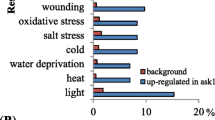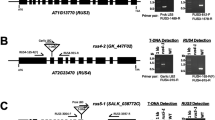Abstract
The yeast Skp1 protein is a component of the SCF complex, an E3 enzyme involved in the specific protein degradation pathway via ubiquitination. Skp1 binds to F-box proteins to trigger specific recognition of proteins targeted for degradation. SKP1-like genes have been found in a variety of eukaryotes including yeast, man, Caenorhabditis elegans and Arabidopsis thaliana. The Arabidopsis genome contains 20 SKP1-like genes called ASK (for Arabidopsis SKP1-like), among which only ASK1 has been characterized in detail. The analysis of the expression pattern of the ASK genes in Arabidopsis should provide key information for the understanding of the biological role of this family in protein degradation and in different cellular mechanisms. In this paper, we describe the expression profiles of 19 ASK promoter-GUS fusions in stable transformants of Arabidopsis, with a special emphasis on floral organ development. Four ASK promoters did not show any detectable expression in either inflorescences or seedlings. Our results on the ASK1 expression profile are consistent with previous reports. Several ASK promoters show clear tissue-specific expression (for instance in the connective of anthers or in the embryo). We also found that almost half (9/19) of ASK promoters direct a post-meiotic expression in the male gametophyte. Tight regulation of the expression of this gene family indicates a crucial role of the ubiquitin degradation pathway during development, particularly during male gametophyte development.
Similar content being viewed by others
References
Altschul, S.F., Gish, W., Miller, W., Myers, E.W. and Lipman, D.J. 1990. Basic local alignement search tool. J Mol Biol 215: 403-410.
Arabidopsis Genome Initiative. 2000. Analysis of the genome sequence of the flowering plant Arabidopsis thaliana. Nature 408: 796-815.
Bai, C., Sen, P., Hofmann, K., Ma, L., Goebl, M., Harper, J.W. and Elledge, S.J. 1996. SKP1 connects cell cycle regulators to the ubiquitin proteolysis machinery through a novel motif, the F-box. Cell 56: 263-274.
Bailey, T.L. and Elkan, C. 1994. Fitting a mixture model by expectation maximization to discover motifs in biopolymers. In: Proceedings of the Second International Conference on Intelligent Systems for Molecular Biology, AAAI Press, Menlo Park, CA, pp. 28-36.
Bate, N. and Twell, D. 1998. Functional architecture of a late pollen promoter: pollen specific transcription is developmentally regulated by multiple stage-specific and co-dependent activator elements. Plant Mol. Biol. 37: 859-869.
Bechtold, N., Ellis, J. and Pelletier, G. 1993. In planta Agrobacterium mediated gene transfer by infiltration of adult Arabidopsis thaliana plants. CR Acad. Sci. Paris (III) 316: 1194-1199.
Brunel, D., Froger, N. and Pelletier, G. 1999. Development of amplified consensus genetic markers (ACGM) in Brassica napus from Arabidopsis thaliana sequences of known biological function. Genome 42: 387-402.
Callis, J. and Vierstra, R.D. 2000. Protein degradation signaling. Curr. Opin. Plant Biol. 3: 381-386.
Cartea, M.E., Migdal, M., Galle, A.M., Pelletier, G. and Guerche, P. 1998. Comparision of sense and antisense methodologies for modifying the fatty acid composition of Arabidopsis thaliana oilseed. Plant Sci. 136: 181-194.
Christensen, C.A., King, E.J., Jordan, J.R. and Dews, G.N. 1997. Megagametogenesis in Arabidopsis wild type and the Gf mutant. Sex. Plant. Reprod. 10: 49-64.
Ciechanover, A., Orian, A. and Schwartz, A.L. 2000. Ubiquitinmediated proteolysis: biological regulation via destruction. Bioessays 22: 442-451.
Connelly, C. and Hieter, P. 1996. Budding yeast SKP1 encodes an evolutionarily conserved kinetochore protein required for cell cycle progression. Cell 86: 275-285.
Dieterle, M., Zhou, Y.-C., Schäfer, E., Funk, M. and Kretsch, T. 2001. EID1, an F-box protein involved in phytochrome A-specific light signaling. Genes Dev. 15: 939-944.
Drouaud, J., Marrocco, K., Ridel, C., Pelletier, G. and Guerche, P. 2000. A Brassica napus skp1-like gene promoter drives GUS expression in Arabidopsis thaliana male and female gametophytes. Sex. Plant Reprod. 13: 29-35.
Estelle, M.A. and Somerville, C.R. 1987. Auxin-resistant mutants of Arabidopsis thaliana with an altered morphology. Mol. Gen. Genet. 206: 200-206.
Eyal, Y., Curie, C. and McCormick, S. 1995. Pollen specificity elements reside in 30 bp of the proximal promoters of two pollen-expressed genes. Plant Cell 7: 373-384.
Fourgoux-Nicol, A., Drouaud, J., Haouazine, N., Pelletier, G. and Guerche, P. 1999. Isolation of rapeseed genes expressed early and specifically during development of the male gametophyte. Plant Mol. Biol. 40: 857-872.
Gagne, J.M., Downes, B.P., Shiu, S.-H., Durski, A.M. and Vierstra, R.D. 2002. The F-box subunit of the SCF E3 complex is encoded by a diverse superfamily of genes in Arabidopsis. Proc. Natl. Acad. Sci. USA 99: 11519-11524.
Gray, W.M., Del Pozo, J.C., Walker, L., Hobbie, L., Risseeuw, E., Banks, T., Crosby, W.L. Yang, M., Ma, H. and Estelle, M. 1999. Identification of an SCF ubiquitin-ligase complex required for auxin response in Arabidopsis thaliana. Genes Dev. 13: 1678-1691.
Herschko, A. and Ciechanover, A. 1998. The ubiquitin system. Annu. Rev. Biochem. 67: 425-479.
Mercier, R., Vezon, D., Bullier, E., Motamayor, J.C., Sellier, A., Lefevre, F., Pelletier, G. and Horlow, C. 2001. Switch (SWI1): a novel protein required for the establishment of sister chromatid cohesion and for bivalent formation at meiosis. Genes Dev. 15: 1859-1871.
Nacry, P., Camilleri, C., Courtial, B., Caboche, M. and Bouchez, D. 1998. Major chromosomal rearrangement induced by T-DNA transformation in Arabidopsis. Genetics 149: 641-650.
Patton, E.E., Willems, A.R. and Tyers, M. 1998. Combinatorial control in ubiquitin-dependent proteolysis: don't Skp the F-box hypothesis. Trends Genet. 14: 236-243.
Piechulla, B., Merforth, N. and Rudolph, B. 1998. Identification of tomato Lhc promoter regions necessary for circadian expression. Plant Mol. Biol. 38: 655-662.
Thoma, S., Hecht, U., Kippers, A., Botella, J., de Vries, S. and Sommerville, C. 1994. Tissue-specific expression of a gene encoding a cell wall-localized lipid transfer protein from Arabidopsis. Plant Physiol. 105: 35-45.
Thompson, J.D., Higgins, D.G. and Gibson, T.J. 1994. CLUSTAL W: improving the sensitivity of progressive multiple sequence alignment through sequence weighting, positions-specific gap penalties and weight matrix choice. Nucl. Acids Res. 22: 4673-4680.
Twell, D. 2001. The developmental biology of pollen. In: S.D. O'Neill and J.A. Roberts (Eds.), Plant Reproduction, Sheffield Academic Press, Sheffield, UK, pp. 86-153.
Twell, D., Yamaguchi, J., Wing, R.A., Ushiba, J. and McComick, S. 1991. Promoter analysis of genes that are coordinately expressed during pollen development reveals pollen-specific enhancer sequences and shares regulatory elements. Genes Dev. 5: 496-507.
Tyers, M. and Jorgensen, P. 2000. Proteolysis and the cell cycle: with this RING I do thee destroy. Curr. Opin. Genet. Dev. 10: 54-64.
Xu, L., Liu, F., Lechner, E., Genschik, P., Crosby, W.L., Ma, H., Peng, W., Huang, D. and Xie, D. 2002. The SCFCOI1 ubiquitin-ligase complexes are required for jasmonate response in Arabidopsis. Plant Cell 14: 1919-1935.
Yamanaka, A., Yada, M., Imaki, H., Koga, M., Oshima, Y. and Nakayama, K.-I. 2002. Multiple Skp1-related proteins in Caenorhabditis elegans: diverse patterns of interaction with cullins and F-box proteins. Curr. Biol. 12: 267-275.
Yang, M., Hu, Y., Lodhi, M., McCombie, W.R. and Ma, H. 1999. The Arabidopsis SKP1-LIKE1 gene is essential for male meiosis and may control homologue separation. Proc. Natl. Acad. Sci. USA 96: 11416-11421.
Zhang, H., Kobayashi, R., Galaktionov, K. and Beach, D. 1995. p19Skp1 and p45Skp2 are essential elements of the cyclin ACDK2 S phase kinase. Cell 82: 915-925.
Zhao, D.H., Yang, M., Solava, J. and Ma, H. 1999 The ASK1 gene regulates development and interacts with the UFO gene to control floral organ identity in Arabidopsis. Dev. Genet. 25: 209-223.
Author information
Authors and Affiliations
Corresponding author
Rights and permissions
About this article
Cite this article
Marrocco, K., Lecureuil, A., Nicolas, P. et al. The Arabidopsis SKP1-like genes present a spectrum of expression profiles. Plant Mol Biol 52, 715–727 (2003). https://doi.org/10.1023/A:1025056008926
Issue Date:
DOI: https://doi.org/10.1023/A:1025056008926




